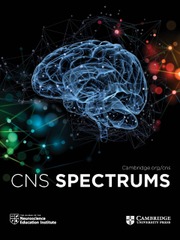Crossref Citations
This article has been cited by the following publications. This list is generated based on data provided by
Crossref.
Fazel, Seena
Wolf, Achim
and
Geddes, John R
2013.
Suicide in prisoners with bipolar disorder and other psychiatric disorders: a systematic review.
Bipolar Disorders,
Vol. 15,
Issue. 5,
p.
491.
Carli, Vladimir
2015.
Identifying inmates that will actually die by suicide.
Evidence Based Mental Health,
Vol. 18,
Issue. 1,
p.
13.
Igoumenou, Artemis
Kallis, Constantinos
and
Coid, Jeremy
2015.
Treatment of psychosis in prisons and violent recidivism.
BJPsych Open,
Vol. 1,
Issue. 2,
p.
149.
Gorodetsky, E.
Carli, V.
Sarchiapone, M.
Roy, A.
Goldman, D.
and
Enoch, M.‐A.
2016.
Predictors for self‐directed aggression in Italian prisoners include externalizing behaviors, childhood trauma and the serotonin transporter gene polymorphism 5‐HTTLPR.
Genes, Brain and Behavior,
Vol. 15,
Issue. 5,
p.
465.
Sarchiapone, Marco
D’Aulerio, Marianna
and
Iosue, Miriam
2016.
Understanding Suicide.
p.
239.
Ozsoy, Sait
Kara, Koray
Teke, Hacer Y.
Turker, Turker
Congologlu, Mehmet A.
Sezigen, Sermet
Renklidag, Tulay
Karapirli, Mustafa
and
Javan, Gulnaz T.
2016.
Relationship Between Self‐Injurious Behaviors and Levels of Aggression in Children and Adolescents Who Were Subject to Medicolegal Examination,.
Journal of Forensic Sciences,
Vol. 61,
Issue. 2,
p.
382.
Verdolini, N.
Murru, A.
Attademo, L.
Garinella, R.
Pacchiarotti, I.
Bonnin, C. del Mar
Samalin, L.
Pauselli, L.
Piselli, M.
Tamantini, A.
Quartesan, R.
Carvalho, A.F.
Vieta, E.
and
Tortorella, A.
2017.
The aggressor at the mirror: Psychiatric correlates of deliberate self-harm in male prison inmates.
European Psychiatry,
Vol. 44,
Issue. ,
p.
153.
Castelpietra, Giulio
Egidi, Leonardo
Caneva, Marina
Gambino, Sara
Feresin, Tamara
Mariotto, Aldo
Balestrieri, Matteo
De Leo, Diego
and
Marzano, Lisa
2018.
Suicide and suicides attempts in Italian prison epidemiological findings from the “Triveneto” area, 2010–2016.
International Journal of Law and Psychiatry,
Vol. 61,
Issue. ,
p.
6.
Sousa, Marta
Gonçalves, Rui Abrunhosa
Cruz, Ana Rita
and
de Castro Rodrigues, Andreia
2019.
Prison officers' attitudes towards self-harm in prisoners.
International Journal of Law and Psychiatry,
Vol. 66,
Issue. ,
p.
101490.
Favril, Louis
2019.
Non-suicidal self-injury and co-occurring suicide attempt in male prisoners.
Psychiatry Research,
Vol. 276,
Issue. ,
p.
196.
Tiscini, Giorgia
and
Lamote, Thierry
2020.
Crime et fonction de la prison : privation de liberté, corps et sens de la peine.
Cliniques méditerranéennes,
Vol. n° 102,
Issue. 2,
p.
193.
Liu, Huinan
Li, Tsz Wai
Liang, Li
and
Hou, Wai Kai
2021.
Trauma exposure and mental health of prisoners and ex-prisoners: A systematic review and meta-analysis.
Clinical Psychology Review,
Vol. 89,
Issue. ,
p.
102069.
Gu, Honglei
Xia, Tiansheng
and
Wang, Lizhao
2023.
Childhood maltreatment and non-suicidal self-injury in prisoners: the mediating role of psychopathy and moderating role of cognitive reappraisal.
Current Psychology,
Vol. 42,
Issue. 11,
p.
8963.
Alcántara-Jiménez, Máxima
Torres-Parra, Isabel
Guillén-Riquelme, Alejandro
and
Quevedo-Blasco, Raúl
2023.
Los Factores Psicosociales en el Suicidio de Presos en Prisiones Europeas: una Revisión Sistemática y Metaanálisis.
Anuario de Psicología Jurídica,
Vol. 33,
Issue. 1,
p.
101.
Rong, Fajuan
Kang, Chun
Peng, Chang
Wang, Mengni
Cheng, Junhan
Ding, Hongli
and
Yu, Yizhen
2023.
Childhood maltreatment and nonsuicidal self-injury among younger Chinese prisoners: the mediating role of self-esteem.
Current Psychology,
Vol. 42,
Issue. 29,
p.
25331.
Santoriello, Carmen
De Rosa, Carmela
Rufo, Chiara
Romano, Francesca
Termoli, Gaetana
Fiorillo, Giuseppina
Caprio, Ludovica
Vitolo, Monica
and
Pagano, Antonio Maria
2024.
Suicide Risk Screening and Assessment before and after the COVID-19 Pandemic in New Inmates.
Healthcare,
Vol. 12,
Issue. 1,
p.
100.

